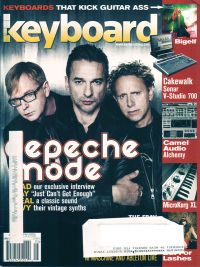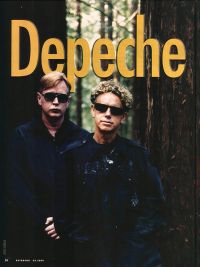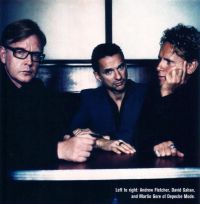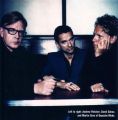2009-05-xx Keyboard - Depeche Mode
| |||||||||||||||||||||||||||||||||||||||||||||||||
Notes
Martin Gore and Andrew Fletcher discuss the production of Sounds Of The Universe alongside album producer Ben Hillier in the May 2009 issue of Keyboard magazine.
Article
FROM THE EDITOR - A QUESTION OF ETHICS
Flash back to fall of 2005. I'm freelancing for Keyboard, playing in bands, teaching college philosophy, and making little to no headway on my alleged Ph.D. thesis. The topic of my ethics class one Thursday was whether it's ever okay to lie, and one of my students quoted Depeche Mode's "Policy Of Truth", whose lyrics warn of the complications of always being totally honest. This would prove to be an omen. After class, my cell phone rings, and the chair of my thesis committee skips all hellos to say, "Get a chapter done by Monday, Mr. Fortner:' Not good — the prof addressing you as "Mr.' is the grad school equivalent of your parents calling out your first, middle, and last name when you were seven. Beep. Saved by call waiting! It's Keyboard, asking if I want to interview Depeche Mode over the weekend. I did a double take. Of course I wanted to interview the band that's arguably why journos first used "electronic" and "rock" in the same sentence. The band cited as an influence by every artist who ever turned a filter knob as they sang about a toxic relationship. The band whose melodies and sound design elevated synthesizers to the level of serious songwriter's instrument in many mainstream eyes. The band loved equally by people who have incompatible takes on '80s night — never miss it, wouldn't be caught dead there, go to be ironic, not old enough to get in. But what to tell my committee chair? "Sorry, gotta go meet some rock stars" wouldn't fly. As we'd say in ethics class, I had a dilemma. I won't say whether I lied to put off that thesis chapter, but I did wind up writing the Depeche Mode story that appeared in Nov, '05, which led in part to my sitting here telling you about this issue, for which the Keyboard team has assembled several great stories. We have a new interview about the new album, playing and programming lessons based on DM classics, plus a back page of eye candy for gearheads. My old class, and more than a few great philosophers, would agree that's more than enough good to cancel the naughty of any itsy-bitsy fibs buried in the history behind it. My former grad school prof? Let's just say I hope I don't run into him at '80s night.
- Steve Fortner
DEPECHE MODE
by Peter Kirn
DEPECHE MODE - Exploring Deeper Space on Sounds Of The Universe
Depeche Mode
The opening of Depeche Mode's Sounds of the Universe came, literally, from a dream. Principal songwriter Martin Gore was visited by synths in his sleep, and by the sound that would kick off the band's latest record. Listen to the first track, "In Chains", and with a click and an expanding drone, you'll hear an orchestra of electronic instruments warm to life and rise into tune, as though emerging from a sonic primordial ooze. "I had a dream about the tuning up of the synths, as an orchestra tunes up'," says Gore. "It so happened that 'In Chains' starts in the key of A minor. So we were able to start the beginning of the album with the A440 tuning tone from the Minimoog, and just recorded, gradually tuning a load of synths to that A." Synth lovers, if you have any doubt that this album is a gift to you, listen to this very first noise on the album: "We thought that only real keyboard aficionados would recognize that initial, little click of the Minimoog [powering up], then the A440 going on."
Talk about a dream: Nearly three decades into the life of Depeche Mode, music is flowing freely from the band's imagination. Assembling Sounds of the Universe, as the epic title may suggest, was painstaking in detail and effort. But with fully-formed musical ideas, a finely-tuned studio overseen by returning producer Ben Hillier, and a playground of vintage synths fueled by Gore's eBay habits, the band was free to create one of the most polished albums in recent years.
Keyboardist and co-founder Andrew Fletcher seems amused at the synthesizers appearing in Gore's sleep: "It's a little bit hippie, isn't it? I didn't have a dream about [the album];' he chuckles — but he's every bit as passionate as Gore about the way the album evolved. When Depeche Mode makes records, it's a quite natural process. We don't have meetings and say, it should go in this direction or that direction. What we do have are Marty's demos and Dave's demos, and we just work from there!"
As on 2005's Playing The Angel (see Keyboard, Nov. '05) the finished album is an intricate reworking of tracks that began as demos from Martin Gore and lead singer David Gahan. As on Angel, too, producer Hillier is a driving force in achieving the completed sound. Fletcher says Hillier is "relentless," with a "clear vision of where things wanted to go. But these ingredients find a new warmth and grit, and a new sense of space (both outer and sonic) that helps Sounds of the Universe to answer even more fully the ambitions of the last album. Songs flowed so copiously, in fact, that the band chose to cut tracks to pare down the album. We spoke to Gore, Fletcher, and Hillier to find out how the musical universe of Depeche Mode has expanded.
Martin, you've talked about this album as having a "spiritual" dimension that's new. Can you describe what you mean?
Martin Gore: I think there are various themes on the record. There are moments where it does go off into some spiritual realm. Two of the songs, I wrote back-to-back: "Peace" followed by "Little Soul". They were, for me, quite spiritual sounding. Although they sound nothing like it, it almost felt a little bit like something from [Stevie Wonder's] Innervisions. There's something spiritual in that sense to them. It might seem really weird to be talking about Stevie Wonder. There's nothing that we ever do that really sounds like somebody else directly. I think it's in my warped head, there's something Stevie Wonder-like about "Little Soul," like there's something Marvin Gaye-like about "In Chains." It's something in the passion you feel from them.
What was the process like as you came into the studio?
MG: The songs were already written and demoed before we got together in the studio. So, versions existed that showed the songs in a certain light. It was just a question of whether we wanted to continue down that path, and just make that version better, or take them off on tangents. We usually spend the first few weeks of an album deciding what we like about the demos and trying out different approaches.
Andrew Fletcher: The great thing is, we don't waste time writing in the studio. The whole process in the studio is to get the best possible vibe and atmosphere for the song. We did four sessions, two in New York, two in Santa Barbara ... we had about 22 songs when we went in the studio. We'd set up in the studio room, not the control room. We'd work on a song for two to three days, stop, move on to another song, then go back [to previous ones] three, four, maybe five times.
Martin, how did you assemble your demos?
MG: I think one of the reasons why I was so prolific writing for this record was that I was doing it all on a laptop. The only time I did anything external to the laptop was when I recorded a vocal or played guitar. That's just so much quicker, to work that way. There's no plugging anything in; it's just all there in front of you. I found it quite inspiring, because I'd never worked that way before.
What software did you use for this?
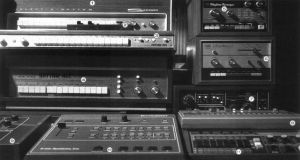
MG: [Apple] Logic, because I find it very simple. Everybody else runs [Digidesign] Pro Tools and Ableton Live. I was really into all this virtual stuff. I literally used to go onto kvraudio.com daily - I think I'm a bit OCD - to see what new soft synth had been released that day, just to check it out. So that was for the recording of the demos. That compulsion moved to real instruments for the recording of the record.
How did you translate these demos to the final version?
Ben Hillier: I think Martin owns pretty much every soft synth in the world! The technique for each song would be first, to get Martin's track - we'd usually end up with it in Ableton because it was much easier to change pitch and tempo. Then we could move it around until we got the key and the speed right for how we wanted to finish the song and how it would fit Dave's vocal best. So we'd start with this finished song, pull it apart, change different parts, then build it back up again. We got to the point where we could do that very easily; it got very free-flowing. Quite often we'd end up with a lot of the lines Martin had programmed during his demos, but reworked on new synths or cut across several different synths.
I understand that Martin has developed something of an eBay habit.
MG: It's funny because Moby is also on our record label, EMI. [Apparently] while I was going through a vintage drum machine fetish, so was Moby. So, I imagine these scenarios where Moby and I are sitting at our computers trying to outbid each other. We used to laugh, saying, what has the universe got in store for us today? Often I would buy things on eBay, and you never know when they're going to turn up. I was having them delivered to the studio, and these boxes would turn up randomly. We'd excitedly open them, and they'd usually find their way onto the track that we're working on. [To learn what gear Martin brought to the sessions, turn to "Geek Out" on page 72. -Ed.] One of the rarer synths that I managed to acquire was a Steiner-Parker Synthacon, which made quite a few appearances on this album. It's got some weird note-stealing thing, if you hit it right, you can play a three-note chord - it'll actually play all three notes at once.
There's a distinctive, coherent sound across all the albums' musically diverse cuts - definitely a signature sound for the band. Can you talk about how your sound has changed over the years?
AF: It's constantly evolving. It's quite obvious if you hear our first album, Speak and Spell, that Martin's writing was different. In the '80s, we were purely an electronic band, although we were originally guitarists. For seven years, we never touched a guitar. Now, we're using it more as a texture on this album. Generally speaking, rather than retro, Universe is a more modern-sounding album. We've used a lot of vintage synthesizers that are much warmer, much grittier, but we've amalgamated them with modern, virtual instruments. When we made Speak and Spell, we only owned three synths.
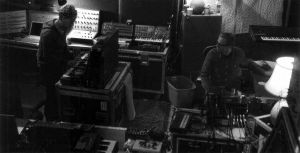
Just having all these instruments coming in was very inspiring.
MG: When you start analyzing all the tracks, they're quite eclectic. There aren't any two tracks that sound the same. They are very different, tempo-wise and feel-wise. But somehow, the whole thing works. I like to think of it as some kind of '60s space-age pop.
Speaking of space-age pop, I hear a little BBC Radiophonic Workshop influence in there — is [composer] Delia Derbyshire in the back of your head, as well?
MG: [Laughs.] Delia's name came up a few times during the making of the record. In fact, Ben was telling us that, oddly enough, his mother gave him — out of the blue — a really early Delia Derbyshire record when he was a kid, and said, "You might like this." So that was there.
There's a rhythmic drive behind this album, too, yes?
MG: I find that this album for us is more uptempo than the last few, possibly because I've been listening to more uptempo music. It's not that we've made an out-and-out dance album, but it's definitely faster than Exciter, which was very ambient and atmospheric. On Universe, we spent a lot of time on the rhythm. Usually the basis of the song came from the drums and bass; that formed the main skeleton, and then the rest of it was icing on the cake. Maybe that's why this one's got a bit more of a drive.
An extraordinary number of bands have been influenced by your sound. What's it like hearing their work?
MG: I never hear Depeche Mode in the bands that cite us as an influence. I think they're more influenced by the instrumentation we've used over the years than by the actual sound. I don't know ... everyone from MGMT to the Killers, I don't really hear Depeche Mode in there. It's a great honor that those bands cite us, but I think it's more the fact that they use keyboards or something.
I'm struck throughout the album that, while it does feel loud in the way the last record did, while there is a density to it, you get a sense of space. Can you talk about how you achieved that?
BH: I think on the last album, we tended to layer things a lot more, and to make it really dense-sounding. On this record, we didn't want to do that. A lot of the things that Martin had been listening to were minimal techno — the sense of space in that sort of music was great.
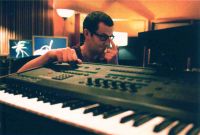
MG: There's a lot of things happening, but somehow there still seems to be an illusion of space. It's nice, because the subtitle for this album is "songs in the key of space."
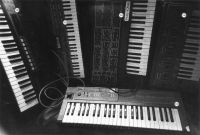
Getting "Wrong" Right
Starting from demos by Gore and Gahan, the band took a "live in the studio" approach to sculpting final song versions, each member having one or more production stations consisting of a MacBook Pro and a slew of vintage synths. They typically worked in free-roll - just letting Live or Pro Tools run like a tape recorder -to get grooves without syncing away the character of parts they'd played live or generated from an analog sequencer or Akai MPC, Producer Ben Hillier (shown above) describes the process for "Wrong",' the album's first single: "The arpeggio that runs throughout 'Wrong' was taken from Martin's soft synth demo, then reprogrammed on my modular synth, using a sine wave from a Cynthia Zeroscillator," says Ben. "We also ran a version using a vintage EMS VCS3 and Tension in Ableton Live - which we recorded through a vintage Gretsch guitar amp in the studio's clanky basement! Different treatments of the sine wave used waveshapers in the modular, Max/MSP, vintage spring reverbs, and guitar pedals. The bass line was originally played live - me on keys, Martin working the filter - on a Roland SH-09. We then doubled it on an Elektron SidStation and Roland Jupiter-6. The drums were from an Akai M PC1000, played in free-run and treated through various bits of modular and EMS synths. We did just a few takes until the timing felt good with the backing track."
GEEK OUT: RIGHTEOUS ROAD RIGS - DEPECHE MODE'S VINTAGE UNIVERSE
At press time, Depeche Mode was still deciding what gear they'd take out on their upcoming tour, though we have heard they're checking out several Muse Research Receptor 2 Pro Max units in their pre-production sessions. In the meantime, here's a peak [sic] behind the scenes at even more of the vintage synths and drum machines the band scored on eBay and brought into the studio while recording Sounds of the Universe. Special thanks to Depeche Mode producer Ben Hillier, and Paul Taylor of Mute Records, for sending us these. Want to do even more gear-spotting? More pics and the full Universe equipment list are at keyboardmag.com.
Images
Left to right: Andrew Fletcher, David Gahan, and Martin Gore of Depeche Mode.
